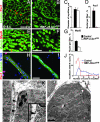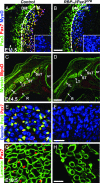RBP-J (Rbpsuh) is essential to maintain muscle progenitor cells and to generate satellite cells
- PMID: 17360543
- PMCID: PMC1815471
- DOI: 10.1073/pnas.0610647104
RBP-J (Rbpsuh) is essential to maintain muscle progenitor cells and to generate satellite cells
Abstract
In the developing muscle, a pool of myogenic progenitor cells is formed and maintained. These resident progenitors provide a source of cells for muscle growth in development and generate satellite cells in the perinatal period. By the use of conditional mutagenesis in mice, we demonstrate here that the major mediator of Notch signaling, the transcription factor RBP-J, is essential to maintain this pool of progenitor cells in an undifferentiated state. In the absence of RBP-J, these cells undergo uncontrolled myogenic differentiation, leading to a depletion of the progenitor pool. This results in a lack of muscle growth in development and severe muscle hypotrophy. In addition, satellite cells are not formed late in fetal development in conditional RBP-J mutant mice. We conclude that RBP-J is required in the developing muscle to set aside proliferating progenitors and satellite cells.
Conflict of interest statement
The authors declare no conflict of interest.
Figures





Similar articles
-
The canonical Notch/RBP-J signaling pathway controls the balance of cell lineages in mammary epithelium during pregnancy.Dev Biol. 2006 May 15;293(2):565-80. doi: 10.1016/j.ydbio.2006.02.043. Epub 2006 Apr 11. Dev Biol. 2006. PMID: 16581056
-
Transcription factor RBP-J-mediated signaling represses the differentiation of neural stem cells into intermediate neural progenitors.Mol Cell Neurosci. 2009 Apr;40(4):442-50. doi: 10.1016/j.mcn.2008.12.008. Epub 2009 Jan 6. Mol Cell Neurosci. 2009. PMID: 19168137
-
Bmp signaling at the tips of skeletal muscles regulates the number of fetal muscle progenitors and satellite cells during development.Dev Cell. 2010 Apr 20;18(4):643-54. doi: 10.1016/j.devcel.2010.02.008. Dev Cell. 2010. PMID: 20412778
-
Notch function in myogenesis.Cell Cycle. 2007 Jun 15;6(12):1451-4. Epub 2007 May 2. Cell Cycle. 2007. PMID: 17581278 Review.
-
Two opposing roles of RBP-J in Notch signaling.Curr Top Dev Biol. 2010;92:231-52. doi: 10.1016/S0070-2153(10)92007-3. Curr Top Dev Biol. 2010. PMID: 20816397 Review.
Cited by
-
Oscillations of Delta-like1 regulate the balance between differentiation and maintenance of muscle stem cells.Nat Commun. 2021 Feb 26;12(1):1318. doi: 10.1038/s41467-021-21631-4. Nat Commun. 2021. PMID: 33637744 Free PMC article.
-
Building muscle: molecular regulation of myogenesis.Cold Spring Harb Perspect Biol. 2012 Feb 1;4(2):a008342. doi: 10.1101/cshperspect.a008342. Cold Spring Harb Perspect Biol. 2012. PMID: 22300977 Free PMC article. Review.
-
The Notch effector Hey1 associates with myogenic target genes to repress myogenesis.J Biol Chem. 2010 Jan 8;285(2):1249-58. doi: 10.1074/jbc.M109.046441. Epub 2009 Nov 16. J Biol Chem. 2010. PMID: 19917614 Free PMC article.
-
Ascl2 inhibits myogenesis by antagonizing the transcriptional activity of myogenic regulatory factors.Development. 2017 Jan 15;144(2):235-247. doi: 10.1242/dev.138099. Epub 2016 Dec 19. Development. 2017. PMID: 27993983 Free PMC article.
-
The quasi-parallel lives of satellite cells and atrophying muscle.Front Aging Neurosci. 2015 Jul 22;7:140. doi: 10.3389/fnagi.2015.00140. eCollection 2015. Front Aging Neurosci. 2015. PMID: 26257645 Free PMC article. Review.
References
-
- Buckingham M. Curr Opin Genet Dev. 2006;16:525–532. - PubMed
-
- Arnold HH, Braun T. Curr Top Dev Biol. 2000;48:129–164. - PubMed
-
- Buckingham M. Curr Opin Genet Dev. 2001;11:440–448. - PubMed
-
- Parker MH, Seale P, Rudnicki MA. Nat Rev Genet. 2003;4:497–507. - PubMed
-
- Ordahl CP, Le Douarin NM. Development (Cambridge, UK) 1992;114:339–353. - PubMed
Publication types
MeSH terms
Substances
Grants and funding
LinkOut - more resources
Full Text Sources
Other Literature Sources
Medical
Molecular Biology Databases

